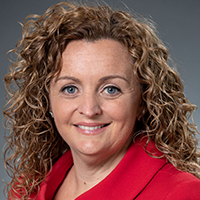
An interview with Katie O’Leary, RN, VP, Post-Acute Care
Katie O’Leary, RN, MPH, was recently named Yale New Haven Health vice president for Post-Acute Care, responsible for developing and implementing a strategy across the health system. Since joining Yale New Haven Hospital in 2012, O’Leary has served in quality and safety leadership positions in the hospital and health system. She was most recently YNHHS executive director of Quality and Safety. O’Leary earned her nursing degree from Sacred Heart University and her master of public health degree from Southern Connecticut State University.
What is post-acute care?
Yale New Haven Health System defines it as any kind of community-based care with skilled components of an agency or a facility, such as skilled nursing facilities and certain home-health agencies.
Are any post-acute care organizations part of Yale New Haven Health?
The Visiting Nurse Association of Southeastern Connecticut in New London, Grimes Center in New Haven and Home Care Plus in Milford are part of YNHHS. The health system also has an established, coordinated care network to which we refer patients in communities throughout the state.
Does post-acute care start after hospital discharge?
That’s a common misconception. In reality, nationwide, only about one-third of patients receive post-acute care after leaving the hospital. Two-thirds receive what could be called “pre-acute care.” Many of these patients are referred by their community-based physicians because they’re experiencing an issue or illness that requires skilled care that could be best provided at home or in a skilled facility.
Do some of these patients end up in the hospital anyway?
If a patient truly requires hospital care, of course, that patient will need to be hospitalized. However, community physicians don’t always have easy access to services that would help them best manage patients requiring additional, skilled care outside the hospital. Often, patients are admitted to the hospital so these services can be coordinated. This is a nationwide issue.
How can patients be better managed?
Here is an example: If a patient with diabetes has a sudden concern and calls his or her doctor’s office, asking to be seen quickly, the doctor would have an option for a skilled provider, such as a home-care nurse, to evaluate the patient before he or she is seen. That patient could be served much more effectively than if the doctor suggests he or she go to the emergency department.
How is YNHHS addressing this?
As we move into 2020, YNHHS has committed to several strategies that involve looking at the “whole patient,” particularly outside the hospital environment. One strategy involves the health system, including its Northeast Medical Group physician practices, joining with Yale Medicine and Community Medical Group to consider a clinically integrated network. Network members agree to use similar protocols to ensure patients receive the same types and levels of care regardless of where they go. Post-acute care protocols will be among the elements that support the clinically integrated network.
What else is being done to ensure patients get the most appropriate care?
The health system’s Post-Acute Care Executive Committee has identified three strategies. The first is to create clear ways to access post-acute care services, such as one phone number physicians can call to find the most appropriate provider. The second strategy is to ensure post-acute care providers within and outside YNHHS are providing the care signature experience we expect for any patient. Finally, YNHHS is working to expand an existing network of post-acute services, including home infusion, home-health agencies, skilled nursing facilities and others to provide the highest-quality care to more patients.
Why is post-acute care important to YNHHS?
With an overwhelming need for emergency department and inpatient hospital services, we must have a robust plan to manage patients who can be appropriately served in the community or at home. Most of our patients would rather be in their own homes instead of the hospital. Our plan will free up hospital beds, and at the same time extend the exceptional care we provide. The most important question that’s guiding all of our work in improving post-acute care is, “what’s right for our patients?”

